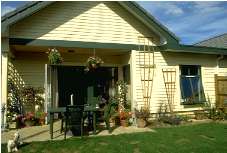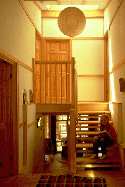 |  | |||||||||
THE GOOD SELF BUILD GUIDE |  | ||||
ENERGY IN BUILDINGS
In Britain, although our weather pattern is not generally harsh, this means an input of energy and we have been consuming this energy at unsustainable levels. Most of it has been derived from fossil fuels, which we now realise are finite, polluting and contribute to climate change. GOOD BUILDING can help to remedy this. Buildings consume some energy in their construction. This is known as ‘embodied energy’ and we consider it later in this guide. In this section we are concerned with the possibilities of reducing ‘energy-in-use’ i.e. the energy costs involved in servicing the building over its lifetime. This end-use accounts for about 30% of our total national energy bill. Most of this energy is used for space heating, followed by water heating, cooking, lighting and ventilation. SOLAR GAINS The sun warms us, the wind chills us, and so it is with our houses. In the SITE section we recommend placing the building so that it is sheltered as far as possible from the wind and rain and is exposed to the sun (to give the benefit known as “passive solar gain”). Further protection from the wind may be achieved by providing porches to all major entrances. South facing conservatories usefully preheat the air entering the home. Use the orientation and materials of construction to absorb and store solar energy, to be re-emitted as usable heat as the building cools after sundown. Place the vast majority of glazing on south facing walls and roofs (may be up to 30 degrees east or west of south), with the main living areas facing roughly south. Materials with high mass are particularly good at absorbing the solar heat entering a building. A high thermal mass building will have solid floor slabs and thick masonry walls and chimney breasts, but these are not always the most ‘self buildable’. Elsewhere in the GUIDE we extol the advantages of light weight, timber-frame construction. This is less good for storing heat but does have the advantage of a quicker response to heat input - the building warms up faster. It is perfectly possible to build a hybrid version - eg. a structural timber frame incorporating some thermal mass, in the ground floor or internal walls. On specific sites it may be beneficial to modify this orientation to take account of view, access, shelter from wind etc. For a building to be truly autonomous, self-sufficient or ‘zero-energy’, it will need to incorporate some means of generating energy from a renewable resource. In practice in the future this is likely to mean installing photovoltaic (PV) cells as part of the roof or wall covering. These cells generate electricity directly from sunlight, but at present their cost is prohibitive for normal domestic buildings. You should consider using the south face of your building for siting solar water heating appliances. DIY collectors are cheap and easy to make and repair, but being fairly inefficient need to be rather large (around 6 Sq mtrs of collector surface per average dwelling.) The Centre for Alternative Technology produce a guide to building and installing your own solar water heating panels, called ‘Tapping the Sun’. There are a range of commercially available panels, from simple ‘flat plate collectors’, to the more expensive but more efficient ‘evacuated tubes’. The latter take longer to repay their primary cost in money terms, but all types of panel make significant reductions in water heating bills, however far north in the UK you are. There are Solar Clubs currently operating in Leicester and Bristol which help householders instal solar water heating for about £1000, through training, sharing equipment and bulk purchase. They also operate a financial package to spread the cost over time. OTHER ENERGY INPUTS In our predominantly damp, cool, dull climate, even if we make best use of the sun it will still be necessary to augment it with “manufactured energy” HEATING AND HOT WATER SUPPLY Use space and water heating appliances powered by renewable sources of energy (which can include bio-fuel such as replanted and well seasoned wood). Wood burning entails a large dry storage space and a nearby source of waste wood. Where this is difficult or impossible to achieve, ensure that all appliances are super efficient (eg. condensing boilers for central heating). Many appliances such as fridges and freezers are now rated according to their energy efficiency. Of the fossil derived fuels, natural gas is the preferred choice, because it is the least polluting, followed by oil and Liquid Petroleum Gas (LPG). Buy any electricity from a ‘green’ supplier using renewables. Electricity is itself a poor medium for heating unless there is an abundance of hydra or wind powered supply available. When generated by non renewables at the power station and transmitted to your home, it is highly inefficient and therefore highly polluting. VENTILATION Make use of natural “stack” ventilation devices that employ the natural tendency of warm air to rise. They can be augmented with electric fans that use little current or can be solar powered. Air conditioning plant can be very extravagant in energy as well as potentially unhealthy. LIGHTING Design the building so that rooms are well lit naturally (i.e. not too deep) and where ever possible with windows on two sides. At night electricity can come into its own as a good means for providing light, and this is also an area where sensible energy savings can be made. Highly efficient compact fluorescent (CF) light bulbs are now available which mimic the ‘warm’ light given off by ordinary incandescent bulbs, and do not have the annoying ‘flicker’ associated with fluorescent strip lighting. Although they cost more, every CF buib installed will save about £35 in electricity bills over its life. INSULATION It is by retaining heat gained from whatever source that GOOD BUILDING can make the most dramatic contribution to energy saving. Standards of insulation and air-tightness common for decades in Scandinavia and Canada, and known as ‘super insulation’ when applied here, cut energy consumption sharply. Insulation levels of up to 2OOmm very soon pays for itself in strictly financial terms and is of immense environmental benefit over the lifetime of the house. Insulate roofs, walls, floors, windows and doors to the highest levels physically possible, certainly well above current Building Regulations standards, and with a view to meeting standards well into the next century. Install 300-400mm of cellulose fibre, cork, wool, flax,hemp or similar renewable material, available from the newly opened ecological building centre - Construction Resources. Your choice of insulation material depends somewhat on your cons truction method. For instance, lightweight, dry timber- frame is ideally suited to cellulose fill, which besides being from a renewable source and relatively cheap, has the great advantage of self sealing all gaps in the enclosing structure - but it must be kept dry. Less sensitive to damp but not so convenient to install, and not from a renewable source (though still abundant) is mineral wool. However this is unpleasant to use and may constitute a health risk via emissions of formaldehyde or the fibres themselves. Where the insulation must have mechanical strength and be completely unaffected by moisture, as for the upside-down roof or below concrete floor slabs, then the preferred choice is cork - renewable and sustainably harvested from cork oak trees. Other options include foamed plastics (eg. expanded polystyrene) or foamed glass. Being industrially produced, both have environmental drawbacks and are expensive, but may be justifiable on other grounds. Keep warm air in the building by carefully sealing unwanted gaps in the structure and by draught stripping around doors and windows. Provide controlled ventilation slots in windows to ensure that only the desired number of air changes take place to replace stale humid air with fresh (see Ventilation above). Insulate cold water tanks and pipes against freezing, and hot water pipes against unwanted heat loss. Consider devices for reclaiming heat from stale air or waste water. Whole house mechanical ventilation systems with a built-in heat exchanger will use the heat from air extracted from kitchens and bathrooms, to pre-heat fresh incoming air, Combined heat and power (CHP) systems use waste heat from the exhaust gases of a generator, but are generally only viable on a small community/village scale. GLAZING Windows are almost always areas of huge heat loss in a building, and there are many types of glazing systems available designed to minimise this loss. Two, three or even four panes of glass, some with a low emissivity (low-E) metallic coating, can be used. Inert gases such as argon, between the panes, will add to the insulating effect. It is also important that the window frames are well sealed, so as not to let in unwanted draughts, or let out precious heat. There are some very high quality Scandinavian window frames on the market with good seals and multiple locking points. Elsewhere in the GUIDE we advocate building with locally obtained, easily repairable materials and this is another instance of the need to balance advantages and drawbacks, which you as self builders must decide. For instance, it may be possible for you to manipulate your design to incorporate simple single glazing protected with insulated shutters closable at night and augmented by curtains and blinds. In general, however, we would recommend using low-E double glazing marketed by Pilkington as ‘K’ glass - as the minimum acceptable standard. TOWARDS ENERGY AUTONOMY If you can reduce your energy demands to small proportions, and your location and circumstances allow it, it may be feasible to tap a combination of local resources - wind, sun, water and bio-mass - and become virtually self sufficient in energy. This advice goes to the limit of the scope of this GOOD BUILDING GUIDE, which whilst encouraging you to keep your sights on the ideal, advises you on how to make best use of the conventional energy sources available to nearly all of us.
| |||||

